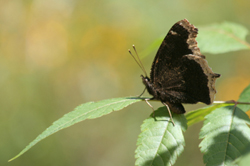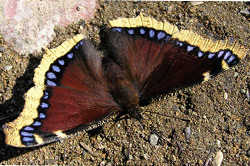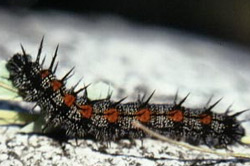State Butterfly Mourning Cloak
Updated: August 10, 2020

The mourning cloak, or Nymphalis antiopa, is Montana's state butterfly. Mourning cloaks belong to one of the larger families of butterflies, the Nymphalidae. Members of the Nymphalidae are more commonly known as the "brush-footed butterflies" because the front pair of legs of these butterflies are small, hairy and "brushlike." The North American common name for this species, mourning cloak, refers to its resemblance to a traditional dark colored cloak worn when one was in mourning.
The mourning cloak's dark brown wings are characterized by bright blue shimmering spots along the inner edge of a yellow or beige border. If viewed closely, you may see that their wings reflect purple highlights. The underside of the wings are dark brown with lighter brown edges.

Mourning cloaks often rest on dark tree bark where they are camouflaged and can bask in direct sunlight. This butterfly will open its wings and angle its body toward the sun to increase its body temperature prior to flight. Combined with its dark wing color, this enables the mourning cloak to absorb heat. Butterflies must be warm to fly so this is important to butterflies living in cold, mountainous areas, especially those that are active in early spring like the mourning cloak.
In the spring, late summer, and early fall mounring cloaks are in flight. They hibernate in the winter, but they come out occasionally during warming periods. They are often the first flitting butterflies to emerge in the spring, frequently before the winter snows have melted. With tree sap as one of their main sources of food, it's an advantage for mourning cloaks to arise so early from hibernation. Sap starts to rise in spring, often seeping out of the bark in places where the tree has been damaged over the winter.
In addition to searching for fresh tree sap, adult mourning cloak butterflies also seek out their mates in the spring. The butterflies die soon after mating, but they have spent as much as ten months as adults, a long life for a butterfly. Before they die, females lay their eggs in clusters of rings around twigs on a single tree or shrub. The eggs hatch into caterpillars, which can grow up to two inches long and are velvety black with raised white dots and a rows of red spots and spines down the middle of their backs.

The caterpillars feed in groups on the leaves of deciduous trees, including the willow, elm, cottonwood, poplar, rose, birch, and mulberry trees. They eat and grow, shedding their skin several times, and eventually leave the plant they've been feeding on. Once it finds just the right spot, the caterpillar will form a spiky gray chrysalis so that it can undergo metamorphosis to become a butterfly. After about ten to fifteen days, depending on the temperature, a new generation of mourning cloak butterflies emerge from their chrysalises.
Thanks to House Bill no. 365, sponsored primarily by James Whitaker, this truly remarkable butterfly was designated Montana's official state butterfly in 2001.
Updated: August 10, 2020

